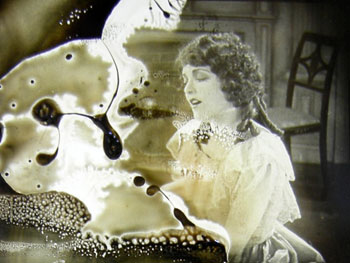Why Preserve Film?
Movies have documented America for more than one hundred years. Since Thomas Edison introduced the movie camera in 1893, amateur and professional filmmakers have used motion pictures to tell stories, record communities, explain the work of business and government, and illustrate current events. They captured, with the immediacy unique to the moving image, how generations of Americans have lived, worked, and dreamed. By preserving these films, we save a century of history.
 |
|
Surviving reels of Maytime (1923) already showed signs of nitrate decay.
|
Unfortunately, movies are not made to last. Created on perishable plastic, film decays within years if not properly stored. Already the losses are high. The Library of Congress has documented that only 20% of U.S. feature films from the 1910 and 1920s survive in complete form in American archives; of the American features produced before 1950, about half still exist. For shorts, documentaries, and independently produced works, we have no way of knowing how much has been lost.
For Hollywood, the tide has turned. Commercial producers now invest heavily in the protection of their film libraries. With the development of television, home video, DVD, cable, and Internet exhibition, Hollywood sound films have become valuable assets and have many markets after their initial release.
Still at risk, however, are documentaries, silent-era films, anthropological footage, avant-garde works, newsreels, home movies, works made for ethnic communities, industrial films, and other independent productions. We call these orphan films because they fall outside the scope of commercial preservation programs. Orphan films may document viewpoints, traditions, and places not depicted in the mainstream media and have a cultural value that transcends their simple origins. They often survive as one-of-a-kind copies in archives, libraries, museums, universities and historical societies. These organizations are the first line of defense for saving American movies made outside of Hollywood.
 |
|
Preservationists at the Selznick school measuring the shrinkage of 16mm film.
|
Preservationists fight film deterioration by protecting the film originals and sharing the content with the public through copies. This involves three basic steps:
- printing old film onto new, more stable film stock,
- storing the original film and new master under cool-and-dry conditions, and
- providing public access through surrogate video, DVD, and film copies.
Access is the final but essential stage in the process. By investing in saving film on film and storing it properly, we make sure that movies will be here to be studied and enjoyed for years to come.
The laboratory work necessary to save a film is expensive. In 2010, making a new master and viewing print of a seven-reel black-and-white silent feature costs about $18,115, assuming that no special restoration work is required. Making a supervised digital video for public viewing adds another $3,000 to the total. Preserving a sound feature costs even more.
The NFPF helps nonprofit and public organizations across the country do this work and share the results with film enthusiasts everywhere. Please help us keep American film alive.
